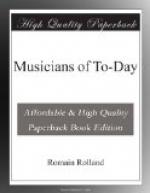Nothing could have better completed the musical education of the public than this continuous defile, for the past ten years, of Kapellmeister and foreign virtuosi, and the comparisons that their different styles and interpretations afforded. Nothing has better helped forward the improvement of Parisian orchestras than the emulation brought about by the meetings between Parisian conductors and those of other countries. At present our own conductors are worthy rivals of the best in Germany. The string instruments are good; the wood has kept its old French superiority; and though the brass is still the weakest part of our orchestras, it has made great progress. One may still criticise the grouping of orchestras at concerts, for it is often defective; there is a disproportion between the different families of instruments and, in consequence, between their different sonorities, some of which are too thin and others too dull. But these defects are fairly common all over Europe to-day. Unhappily, more peculiar to France is the insufficiency or poor quality of the choirs, whose progress has been far from keeping pace with that of the orchestras. It is to this side of music that the directors of concerts must now bring their efforts to bear.
The Lamoureux Concerts have not had as stable a dwelling-place as the Chatelet Concerts. They have wandered about Paris from one room to another—from the Cirque d’Hiver to the Cirque d’Ete, and from the Chateau-d’Eau to the Nouveau Theatre. At the present moment they are in the Salle Gaveau, which is much too small for them. In spite of the progress of music and musical taste, Paris has




